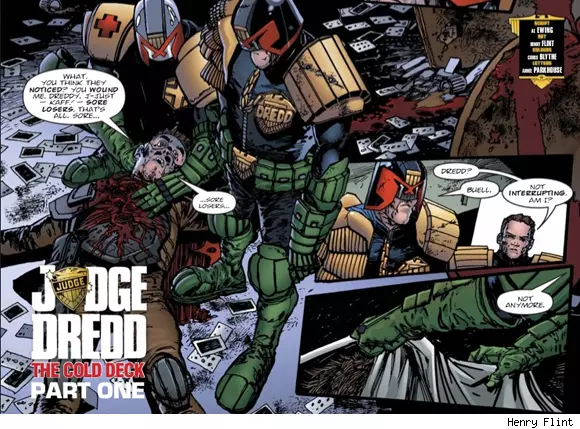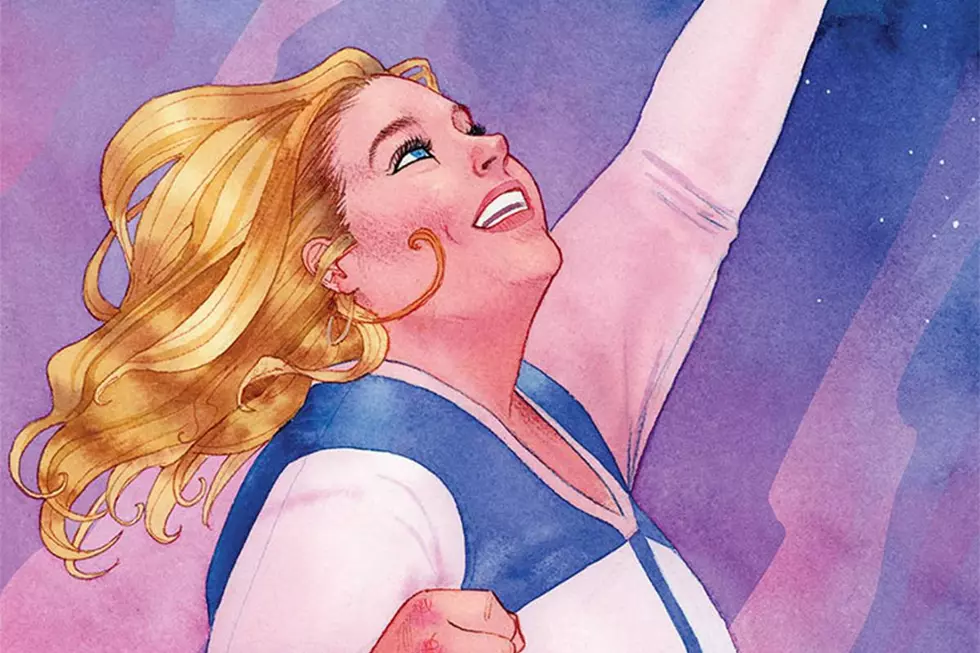
2000 AD’s ‘Trifecta’ Crossover Is Hereby Declared The Best Event Comic of 2012

Let me be the first to apologize to you, on behalf of the entire comics press. We screwed up. We were too focused on the wrong events in 2012. We spent tens of thousands of words on Avengers vs X-Men, Before Watchmen, Night of the Owls, and we missed the fact that there was a bigger, better, and extremely satisfying crossover sitting right under our noses. Not all of us -- a few of our ranks were on the ball enough to realize what we had, but too many missed this. But it's okay. I've seen the error of my ways. I've seen the light. I had my road to Damascus moment, and now I'm here to spread the word about the spectacular crossover that ran in 2000 AD late last year and ended up being one of the year's best stories. What's the name of it, you ask? Well, here's the thing: it didn't have one.The crossover ran between three strips in 2000 AD. Writer Al Ewing and artist Henry Flint's "The Cold Deck," beginning in prog 1806, focused on Judge Dredd attempting to pick up the pieces after the events of the apocalyptic "Day of Chaos" story. Millions are dead, Mega-City One is in ruins, but life goes on. The guilty must be judged and justice must be served.
Artist Simon Coleby and writer Simon Spurrier began "The Simping Detective: Jokers to the Right" in prog 1804. It stars Jack Point (Point as in "held at gun...", of course), a clown-faced private eye with a bag full of chips on his shoulder. He works out of Angeltown, and Simons Spurrier and Coleby have created a story that feels like a down and dirty sci-fi Los Angeles that sits next door to the good old days of films noir, from Point's narration (Point, as in "get to the") to the locales he spends his time drinking, sleeping, and crawling through.

"The Cold Deck," written by Al Ewing, drawn by Henry Flint, lettered by Annie Parkhouse, and colored by Chris Blythe.
The last piece of the puzzle is "Low Life: Saudade" from prog 1805, which comes courtesy of artist D'Israeli and writer Rob Williams. It stars Dirty Frank, a genuinely unhinged undercover agent for the Judges. He speaks in the third person, he narrates his own life, he's not too quick on the uptake, and boy oh boy does he spend all of his time confused by everything. One day, he wakes up (wait for it) on the moon (keep waiting, that ain't it) where he's become massively rich (nope) and a shareholder in a company run by a human being who is so dedicated to a gimmick that he had his genes spliced with a great white shark... he's got a shark head, boy dudes and lady dudes (there we go). Frank, of course, not only has no memory of how he got there and why he's rich, but he has no clue what he's expected to do. It's an undercover assignment like no other, and Dirty Frank is an undercover agent like no other. What could go wrong?
Notice how none of these stories even remotely sound like they should cross over? The tones are different, for one thing. Ewing's Dredd reads a little like Frank Miller's Batman circa Dark Knight Returns. Spurrier's Jack Point is a hard luck hero, but only if your definition of heroism includes craven selfishness, permanent exasperation, and taking advantage of people. He's got bad luck, at least. And Frank? Frank is weird. Let's leave it at that.
Now, if you read comics, you know how events work by this point. Sometimes they get announced a year ahead of time and sometimes they get announced six months out, but you always know they're coming. Once they hit, you get ugly banners on your comics, and series that interact with the event are often stripped of their own voice or plots, so as to better tie in with the presumably record setting sales of the event. After that, we have the epilogue or aftermath period, where we read about people reacting to that thing that just happened. The aftermath, at this point, is often setup for the next event, or a clunky way to set up the official post-event status quo. YUCK, right? Sometimes you'll get a good story out of one of the tie-ins, but by and large, these kinds of events aren't really what I'm looking for in comics.

"Low Life: Saudade," written by Rob Williams, drawn by D'Israeli, and lettered by Ellie De Ville.
The creative types involved skipped all that rigamarole. The crossover wasn't announced, though once it hit, there was some light press coverage. Instead of leaving flyers and leaflets all over the internet, the event just happened. The stories involved in the crossover began in separate issues. One of them's black and white, another is black and white with bursts of color, and the other is full color. They began in separate issues, too. While they share a setting and context -- Dirty Frank and Jack Point are Dredd spinoff characters -- there's nothing that suggests they'll crossover until you turn a certain page and realize that the story that you just finished leads directly into the story that you just began.
I knew the crossover was coming, though I was behind on 2000 AD when it happened. It's hard to avoid comics news, says the guy who writes for a comics news site, so I knew the broad strokes of the crossover going in. But I avoided reading any further, because I knew I'd be getting there on my own. I tend to read 2000 AD in chunks, and I caught up with a couple months' worth of thrill power over the course of a few days. Even knowing that at some point two other series were going to intersect with Dredd, I was still caught by surprise.
It was the elegance that did me in. I know a little bit of Dredd lore, but I don't know anything about Jack "What's the" Point or Dirty Frank. But Spurrier, Ewing, and Williams did a great job of making this crossover new reader friendly. They dig deep into Dredd lore, introduce characters I didn't know existed, but they don't act as if we should instantly know the import of every character who is introduced on a "to be continued" page. Us newbies get the context we need to understand why certain characters are meaningful. It feels like the writing team treated every character like someone new. I still don't know if a few of the named judges were previously established or brand new, and I'm pretty happy about that.

"The Simpering Detective: Jokers to the Right," written by Simon Spurrier, drawn by Simon Colby, and lettered by Simon Bowland.
I mentioned earlier that each of the series looks completely different. It's true, and that's part of why the crossover is so good. Flint's Dredd is grimy and dirty, D'Israeli's work on "Low Life" is just this side of cartoony slapstick at times, and Coleby's style on "The Simpering Detective" puts me in mind of artists like Gabriel Hardman. The raggedy clothing, the approach to faces... "The Simpering Detective" may actually have my favorite art out of the entire crossover.
The crossover ends in an issue-length blowout story called "Trifecta," scripted by the three writers of the crossover and featuring all three threads coming together at once. It's drawn by Carl Critchlow, and it's fascinating to see his take on the cast. Rather than trying to ape D'Israeli, Coleby, or Flint, he does his own thing. Dirty Frank lives up to his name. He looks filthy, instead of lovably dirty. Dredd is pretty similar, but that's a look that really works for Dredd. Jack Point's part of the trifecta reminds me of... imagine a Frazer Irving comic, right? That visual style? Keep the kinetic energy and creepiness and acting, but color it with a more muted palette. That isn't quite what Critchlow is working with, but that's as close as I can get to explaining it. Regardless: it looks good.
It reads good, too. There's no trade or anything available yet, but you can buy progs 1804-1812 and get the full story and more besides. I read it in 2013, but it was one of the most enjoyable comics to be released in 2012. Now I'm looking to see what everyone else does next, which is probably the best result you can expect from reading a comic. Bravo, gentlemen.
More stories like that, please.



2000 AD issues are available at your local comic shop, on iTunes, and on the 2000 AD website.
More From ComicsAlliance
![Judge Dredd Takes On Fairlyhyperman In ‘The Cape & Cowl Crimes’ [Preview]](http://townsquare.media/site/622/files/2017/03/Dredd00.jpg?w=980&q=75)
![The Earth Just Ain’t For Us: The Inhuman ‘Royals’ Take To The Stars [Preview]](http://townsquare.media/site/622/files/2017/03/Royals-0.png?w=980&q=75)
![The Law Returns To The Moon In ‘Judge Dredd Annual 2017′ [Preview]](http://townsquare.media/site/622/files/2017/02/Dredd00.jpg?w=980&q=75)

![Fighting Fantasy Comes To Comics With ‘Ian Livingstone’s Freeway Fighter’ [Exclusive]](http://townsquare.media/site/622/files/2017/02/FreewayFighter00.jpg?w=980&q=75)


![The Best Dark Horse Comics Covers of 2016 [Gallery]](http://townsquare.media/site/622/files/2017/01/featured.png?w=980&q=75)

